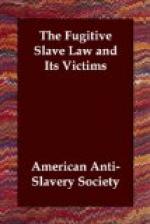him to urge the Court to continue the case. Judge
Flinn said—“The case will he
decided to-night; that is decided on. We
have not been silting here four or five hours to
determine whether we will decide the case or not.
It will be decided, and you may come up to it
sideways or square; or any way you please; you
must come to it.” Mr. Zinn said he was
not going to argue. He had made the request out
of courtesy to a professional brother. He
doubted the power of the Court to deliver the
boy into slavery. Judge Flinn said—“I
do not wish to hear any arguments of that nature.”
The man was then ordered to be taken by the Sheriff,
and delivered to claimant on board the boat,—which
was done.—Cincinnati Gazette,
27th August, 1853.
PATRICK SNEED, a colored waiter in the Cataract House, Niagara Falls, arrested on the pretended charge of murder committed in Savannah, Georgia. He was brought, by Habeas Corpus, before Judge Sheldon, at Buffalo, (September, 1853,) and by him ordered to be “fully discharged.”
BILL, [or WILLIAM THOMAS,] a colored waiter at the Phenix Hotel, Wilkesbarre, Penn., described as a “tall, noble-looking, intelligent, and active mulatto, nearly white,” was attacked by “Deputy Marshal Wynkoop,” Sept. 3, 1853, and four other persons, (three of them from Virginia.) These men came “suddenly, from behind, knocked him down with a mace, and partially shackled him.” He struggled hard against the five, shook them off, and with the handcuff, which had been secured to his right wrist only “inflicted some hard wounds on the countenances” of his assailants. Covered with blood, he broke from them, rushed from the house, and plunged in the river close by, exclaiming, “I will be drowned rather than taken alive.” He was pursued, fired upon repeatedly, ordered to come out of the water, where he stood immersed to his neck, or “they would blow his brains out.” He replied, “I will die first.” They then deliberately fired at him four or five different times, the last ball supposed to have struck on his head, for his face was instantly covered with blood, and he sprang up and shrieked. The by-standers began to cry “shame” and the kidnappers retired a short distance for consultation. Bill came out of the water and lay down on the shore. His pursuers, supposing him dying, said, “Dead niggers are not worth taking South.” Some one brought and put on him a pair of pantaloons. He was helped to his feet by a colored man named Rex; on seeing which, Wynkoop and party headed him and presented their revolvers, when BILL again ran into the river, “where he remained upwards of an hour, nothing but his head above water, covered with blood, and in full view of hundreds who lined the banks.” His claimants dared not follow him into the water; for, as he said afterward, “he would have died contented, could he have carried two or three of them down with him.” Preparations [rather slow it would




